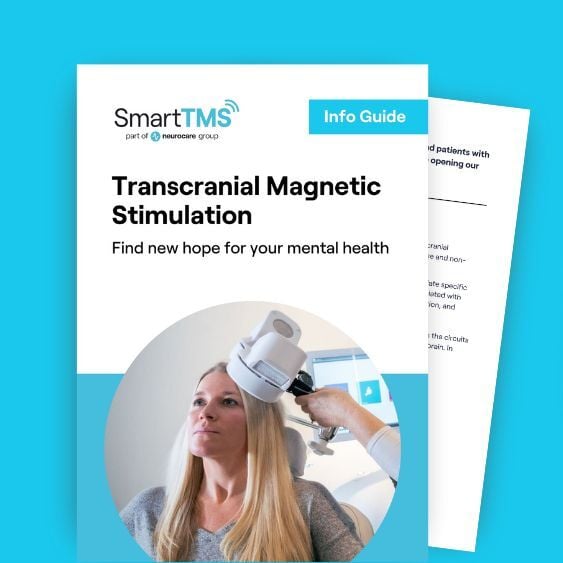What is Cerebral Palsy?
June 6, 2024 - Smart TMS

Cerebral palsy (CP) can be defined as a collection of conditions which primarily affect movement and posture but can also affect cognitive functioning. The condition is usually the result of damage sustained to the developing brain either pre or postnatally.
CP can be a truly debilitating condition and usually has a profound effect not only on those who suffer from the condition but also their family members. In an extensive survey of CP patients in Europe (2022) it was found that:
- 50% have speech and language difficulties
- 30% are wheelchair-bound
- 30% are severely intellectually impaired
- 10% have severe visual impairment
- 20% have active seizures
It can be difficult for CP sufferers to achieve some measure of normality considering the physical impediments that their condition often causes. As it is a heterogenous condition the extent to which a person is affected can vary from mild to profound.
Symptoms of Cerebral Palsy
Cerebral palsy comprises a heterogenous population and includes a wide range of symptoms across movement, posture, speech, eating and development.
Some of the common symptoms include:
- Stiff muscles and exaggerated reflexes (spasticity)
- Lack of balance and muscle coordination (ataxia)
- Variations in muscle tone
- Difficulty walking
- Delays in speech development
- Trouble with sucking, chewing or eating
- Drooling or trouble with swallowing
- Learning disabilities
- Intellectual disabilities
- Delayed growth
(Mayo Clinic, 2024)
Diagnosing Cerebral Palsy
Cerebral palsy is one of the leading causes of disability among children with a prevalence of 2.08 per 1000 live births (Antczak, 2021; Oskoui, 2013). Often it can be difficult to diagnose CP. If a child is suspected to have a developmental disorder, parents and medical professionals work together to monitor the child’s development, conduct developmental screenings and/or medical evaluations. Specialists may suggest brain imaging tests, such as x-ray computed tomography (CT scan) or magnetic resonance imaging (MRI). In complex cases electroencephalogram (EEG), genetic testing, or metabolic testing may also be carried out (CDC, 2022). However, CP can be tricky to diagnose and often children do not receive a formal diagnosis until they are two years old.
Two studies have recently been conducted which have utilised TMS to uncover a negative association between contralateral motor evoked potentials following ipsilesional stimulation and the development of atypical movements in the first year of life and a subsequent diagnosis of CP (Nemanich et al., 2019; Kolawski et al., 2019). This demonstrates the potential utility of TMS as a diagnostic tool for a condition that is otherwise difficult to diagnose.
Treating Cerebral Palsy
Treating patients with CP can prove even more difficult than the diagnostic journey due to the often widespread effects of the condition. As discussed above the varied nature of symptomatology means that each case is different, and treatment can vary widely from patient to patient.
Some of the most common forms of treatment for CP include:
- Physical therapy and rehabilitation
- Occupational therapy
- Recreational therapy
- Speech and language therapy
- Orthotic devices
- Assistive devices and technologies
- Medication
- Surgery
(National Institutes of Health, 2021)
Researchers have begun investigating the possible therapeutic effect of TMS on CP patients, some of the studies yielding promising results. Kirton et al. (2008), reported a statistically significant improvement in grip strength among CP patients who received TMS treatment while Gillick et al. (2014) found a similar improvement in a CP cohort following TMS treatment in the Assisting Hand Assessment. Unfortunately, the treatment condition in both these studies was brief with only a handful of sessions administered and the positive changes were not sustained beyond six months. There is evidence that the greater number of sessions received, the greater the positive changes sustained with improvement of scores on the gross motor function measure found to be proportional to the number of TMS sessions received (Rajak et al., 2019).
Besides the physical benefits observed in CP patients from TMS, some studies have also found cognitive benefits. Ghupta & Bhatia (2018) discovered that TMS improves learning ability in CP children and caused a boost in EEG measured alpha power and other potentially positive electroencephalographic changes. Their conclusion impressed the clinical importance of TMS as a learning and therapeutic tool for children with neurological conditions.
Smart TMS and Cerebral Palsy
Currently the research on the effects of TMS on CP is somewhat sparse and it is apparent that a significantly greater volume of clinical trials must be undertaken to confirm the efficacy of treatment on such a vulnerable population. For these reasons, cerebral palsy is not currently a condition that we treat at Smart TMS. However, as more research surfaces on the therapeutic importance of TMS for CP we will be in a better position to consider the possibility of implementing a therapeutic intervention for this population.
Written by our Dublin practitioner, Joe.
References
- Antczak J.M., (2021) Transcranial magnetic stimulation as a diagnostic and therapeutic tool in cerebral palsy. Postep Psychiatr Neurol.;30(3):203-212.
- Gillick BT, Krach LE, Feyma T, Rich TL, Moberg K, Thomas W, et al. (2014) Primed low-frequency repetitive transcranial magnetic stimulation and constraint-induced movement therapy in pediatric hemiparesis: a randomized controlled trial. Dev Med Child Neurol; 56: 44-52
- Gupta, M., & Bhatia, D., (2018) Evaluating the Effect of Repetitive Transcranial Magnetic Stimulation in Cerebral Palsy Children by Employing Electroencephalogram Signals Ann Indian Acad Neurol.; 21(4): 280–284
- Kirton A, Chen R, Friefeld S, Gunraj C, Pontigon AM, Deveber G. (2008) Contralesional repetitive transcranial magnetic stimulation for chronic hemiparesis in subcortical paediatric stroke: a randomised trial. Lancet Neurol; 7: 507-513
- Kowalski JL, Nemanich ST, Nawshin T, Chen M, Peyton C, Zorn E, et al. (2019) Motor evoked potentials as potential bio-markers of early atypical corticospinal tract development in infants with perinatal stroke. J Clin Med; 8: 1208.
- National Center on Birth Defects and Developmental Disabilities, CDC (2022) Screening and Diagnosis of Cerebral Palsy https://www.cdc.gov/ncbddd/cp/diagnosis.html
- National Institutes of Health (2021) What are common treatments for cerebral palsy? https://www.nichd.nih.gov/health/topics/cerebral-palsy/conditioninfo/treatments
- Nemanich ST, Chen CY, Chen M, Zorn E, Mueller B, Peyton C, et al. (2019) Safety and feasibility of transcranial magnetic stimulation as an exploratory assessment of corticospinal connectivity in infants after perinatal brain injury: an observational study. Phys Ther; 99: 689-700.
- Oskoui M, Coutinho F, Dykeman J, Jetté N, Pringsheim T. (2013) An update on the prevalence of cerebral palsy: a systematic review and meta-analysis. Dev Med Child Neurol, 55: 509-519
- Rajak BL, Gupta M, Bhatia D, Mukherjee A. (2019) Increasing number of therapy sessions of repetitive transcranial magnetic stimulation improves motor development by reducing muscle spasticity in cerebral palsy children. Ann Indian Acad Neurol; 22: 302-307
- Surveillance of Cerebral Palsy in Europe (2002). Prevalence and characteristics of children with cerebral palsy in Europe. Dev Med Child Neurol; 44: 633-640
- The Mayo Clinic (2024) Cerebral Palsy https://www.mayoclinic.org/diseases-conditions/cerebral-palsy/symptoms-causes/










